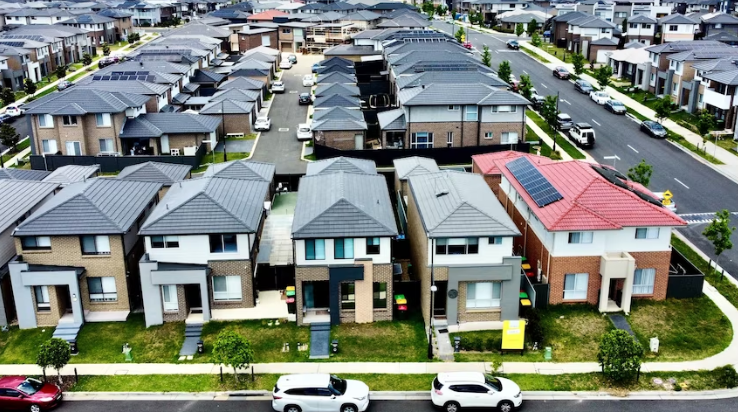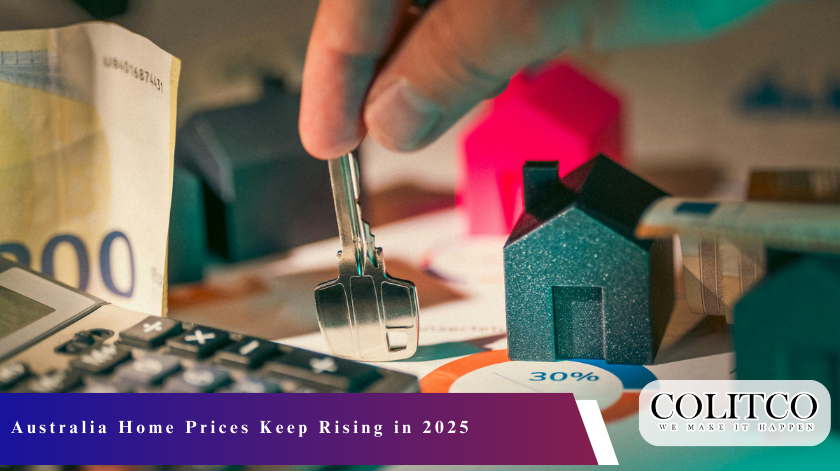In August 2025, we saw yet another reinforcement of the housing market in Australia. For the month, national home values saw a 0.7% increase, marking the 7th continuous monthly increase. This shows how the market is continuing to strengthen.
The national median home value is currently $848,858, which is a 4.1% increase compared to the previous year. Analysts link this increase to sustained demand in an environment of low supply. Both regional and metropolitan areas saw improvements, with buyers competing for the limited number of properties available.

Australia’s housing market rises 0.7% in August, marking seven months of growth.
Why Do Australia Home Prices Keep Rising Despite Affordability Concerns?
As mentioned, there is intense competition among home buyers, which is one of the reasons why prices continue to rise. Advantageous borrowing terms continue to support interest rates, creating a spillover effect for home buying.
Real wages are rising, giving households more buying power; along with supply-side constraints, they create a squeeze on the market. As for supply, the number of property listings is still low. With Australian property listings hovering around 120,000, there are approximately 20% fewer listings than the five-year seasonal average.
This imbalance between demand and supply is heightening the level of competition. Optimistic buyers are increasingly quick to make offers on homes, and prices are rising as a result.
What happens in capital cities and regional markets?
The difference in price changes by region is evident. With a 1.2% increase, Brisbane’s median price is now $949,538. Sydney has the highest median price, which is now $1,224,341, while Melbourne increased by 0.9% to $1,003,467.
Darwin’s median sits at $533,131, which is a 20.2% increase and is also the highest subject to yearly growth. Hobart’s decrease is the smallest, with 0.2%. Lifestyle changes and remote working continue to capture the interest of buyers and investors, along with regional markets, which are continuing to increase in value compared to the capitals.
There is an increasing number of buyers for the high-demand regions, which is driving up the level of competition in the market.
Are rate cuts and government schemes boosting demand?
Yes. The First Homebuyers Guarantee expansion and the Reserve Bank’s further rate cuts are expected to reduce borrowing costs. This combination of initiatives is expected to enhance demand. Such initiatives are designed to lower the barriers to home ownership, especially for first-time buyers.
Both buyers and investors are optimistic about the prospect of further price increases. Buyers concerned about potential price increases are more proactive, enhancing the pace of transactions. The market shows greater activity in areas with the potential for higher appreciation.
Is Low Property Listings Australia Limiting Supply?
Listing volume remains restrained. Evolving market listings are approximately 120,000, falling short of the typical 150,000 listings for this period. While building approvals show modest improvement, they remain under benchmark figures.
Delays in construction and elevated building costs are curtailing new supply. There are indications from analysts that the restrictive supply situation could continue until 2025. In consequence, the demand still exceeds the supply, perpetuating price increases. Homebuyers are likely to encounter stiffer competition, especially in high-demand neighbourhoods.
What are the forecasts for the upcoming months and years?
There is slower growth on the horizon, and this is consistent with current forecasts. AMP’s forecast anticipates a rise in national home prices of 7% this year, which could increase to 10% in 2026. If supply improves, growth may slow in outer suburban and regional areas, as per the analysts.
CBA’s modelling indicates that a 100 basis point rate reduction on interest rates could increase home prices by 9%. The overall growth expected in 2025 has now been revised to 6% from the previous 4%.
Investors Outlook
Property buyers continue to show careful optimism. Their main points of concern are:
- Appreciation of Capital: Brisbane and Darwin are anticipated to experience significant growth.
- Rental Yield: Limited availability is driving rents up, ensuring steady returns.
- Borrowing Power: Additional reductions might improve the ability to borrow, increasing investor interest.
- Sydney & Melbourne: Elevated prices in these cities may inhibit new investors.
- Regional Focus: Investors are increasingly shifting their attention towards regional locations that are experiencing higher demand and possess lifestyle benefits.
While keeping an eye on interest rate changes and supply dynamics, specialists recommend that investors take a strategic approach and plan for the long run.
Also Read: Top ASX Real Estate Stocks Dominating the Market
FAQs
- What keeps pushing home values up australia in Australia?
Ample low-interest loans, increasing salaries, and high buyer optimism contribute to a australia pricier tight stock.
- Has every city noted a price increase?
Brisbane, along with many other cities, australia enjoys an increase of 1.2 per cent. Hobart is the exception, australia recording a decrease of 0.2 per cent.
- How critical is the shortfall in supply?
With 120,000 listings, the shortfall is australia about 20 per cent in comparison to the five-year seasonal average.
- Are prices expected to rise sharply in 2026?
Yes, AMP forecasts a 10 per cent increase in 2026 with sustained low rates.












